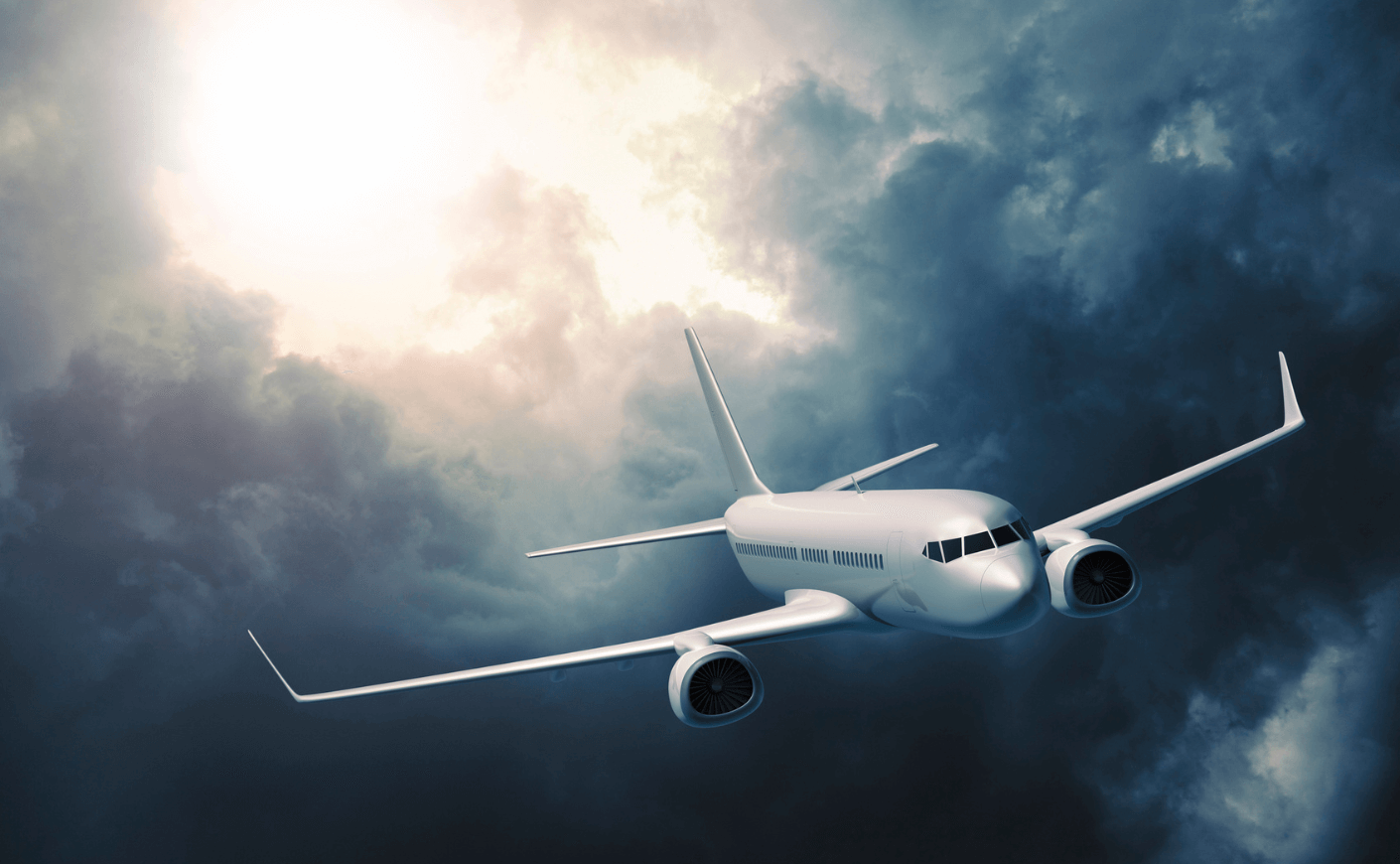If the thought of boarding a plane sends you into a full-blown panic, you’re in good company. Thankfully, this excerpt from the new book How to Win at Travel by Brian Kelly (aka The Points Guy) unpacks why your fear of flying is (statistically speaking) irrational, and how to keep it from ruining your next vacation. So fasten your seatbelt, take a deep breath, and let’s get you ready for takeoff — no white-knuckle grip required.
Can you imagine being so afraid of flying that you hire a bus to drive you cross-country with two full-time drivers so you can make the trip in 30 hours flat? Or being so nervous to step foot on a plane that you hire an anesthesiologist and a private jet to put you under so you can be transported across an ocean?
While I can’t imagine going to these lengths, I do know many people who battle with varying degrees of fear of flying. Aviophobia, aerophobia…it goes by many names, but fear of flying is way more common than you may think. Forty percent of people have some kind of fear around flying.
Flying, especially on commercial jets, is safe — even with the recent incidents making headlines. It’s so safe that it can be difficult to even calculate the odds of dying on a passenger flight, because they’re so low. In the U.S. in 2023, more than 100,000 people died from drug overdoses, more than 43,000 from gun violence, nearly 41,000 from car crashes, and zero from commercial airline crashes. Out of 37.7 million commercial flights in 2023 globally, there was only a single fatal propeller jet crash in Nepal.
There is no other mode of transportation as safe as flying. And it makes sense — the entire global aviation network is highly regulated and monitored. Anyone cleared to fly a commercial plane has passed rigorous training and supervised practical experience, and even when they get in the cockpit, they will spend years being the “number two” before even taking full control of the aircraft. They’re drug-tested, and even then, there are computer systems and redundancies that can help them recover even if mistakes are made. How does that compare to what you see on any highway on a Friday night?
According to research, more than 25 million people in the U.S. are scared of (or at least anxious about) flying, with a reported third of those with a fear so severe it stops them from flying.
Part of fear of flying comes from lack of control, especially when you’re uncomfortably crammed into a tiny seat, the doors snap shut, and your life is in the hands of someone up front that you can’t even see.
Capt. Sully Sullenberger, former U.S. ambassador to ICAO, the International Civil Aviation Organization (and the pilot who landed US Airways Flight 1549 in the Hudson River in 2009 after a bird strike), explained why fear of flying affects so many people — and a lot of it has to do with control. “Riding in a car is a common, everyday occurrence. We understand how cars work, we often know the driver, and we can just pull over and stop. Being in an airplane isn’t an everyday thing, we may not understand the physics of flight, we probably don’t know the pilots, and we can’t just pull over.”
Other factors can come in the form of claustrophobia, fear of heights, panic about germs, fear of crashing, motion sickness, or just plain fear. After safely landing the aircraft in the river, Captain Sullenberger didn’t have any increased anxiety around flying. “I returned to flying as soon as I could. Getting back in the cockpit was like coming home, like putting on a favorite pair of jeans.” Just think — if he can do it, so can you.
You’re not alone in your fear of flying
Understanding you’re not the only one with fear, nerves, or panic can help — just knowing you’re not alone. Having always been interested in how people develop and handle a fear of flying, I had a chat with Whoopi Goldberg. The actor, comedian, author, radio host, television personality, and EGOT winner has a fear of flying that she’s dealt with over the years. In 1978, Whoopi was spending time with family and friends, enjoying a carefree and happy afternoon barbecue, when she looked up, feeling helpless, as two planes headed toward one another. She watched in horror as Pacific Southwest Airlines Flight 182 collided with a private Cessna 172 aircraft in her San Diego neighborhood, one of the deadliest plane crashes ever to occur in California.
Her fear of flying didn’t start right after the crash. “I was fine for a very long time, and then I had a nightmare. And the nightmare was so vivid and so scary, it freaked me out so badly. I just thought, I’m never doing this again. I’m never getting on a plane again. When you see stuff like that, you think, it didn’t happen to me. I’m here. So that was terrible, and move on. But my brain said, I’m gonna shield you from all of this for a while, but I’m gonna wake you up with it at some point, and you’re gonna have to deal with it. And I just literally stopped going anywhere. I bought a bus,” she told me.
Whoopi’s fear of flying was so extreme that she used a bus to travel domestically, hiring two drivers so that she’d be able to get cross-country in just two days. She tried before to get on planes and had panic attacks so intense she couldn’t manage to board or turned around on the jetway and left. Her bus travel plan worked for a while — until she had to fly to Europe to see Sister Act onstage. The only way she could fathom taking the trip was if she didn’t even realize she was flying. So that’s what she did. “We got a private jet and got permission to have an anesthesiologist on the plane. I wanted to wake up there,” Whoopi explained. So Whoopi was put under for the flight, waking up only after the plane had safely landed in London.
These days, she’s flying again. Whoopi’s been able to overcome her fear of flying — perhaps not fully, but enough to get on a plane without being under anesthesia, even flying commercial aircraft between destinations like New York and her vacation home in Italy. If she can do it, you can, too.
Learn how planes operate — and keep you safe
Understanding how planes work (the aviation industry now has sophisticated communication systems and other safeguards to minimize the chances of flight collisions) has made a difference. “Talking to pilots was a big help,” Whoopi said.
“Airplanes are expertly designed, built, and operated, with lots of redundancy and many levels with huge margins of safety. Crews are well-trained and experienced in how the entire system works without you even knowing it, to keep everyone safe,” explained Captain Sullenberger. If hearing from a pilot helps your fear, consider using the Dial a Pilot service, which will connect you with an actual pilot for a 30-minute call for $65. These pilots can reassure you about statistics, turbulence, and other triggers you may have when flying.
But wait: Is turbulence dangerous?
Turbulence is the sudden change in air flow that causes a plane to move, often up and down but sometimes left and right or even in a slight roll. Things like jet streams can cause turbulence to occur; the wake from nearby planes can also cause turbulence. But a plane’s wings can bend and flap without damaging the plane’s structure. Severe turbulence is rare, and while turbulence can always happen, just know your pilots aren’t worried and, according to a pilot, “are always trying to avoid bad weather or change altitudes to offer you a smoother flight.”
Most important, turbulence doesn’t take down modern commercial aircraft. It’s similar to driving and hitting a pothole — sometimes you can see one, but sometimes not. In rare circumstances, it could require maintenance, but most of the time it won’t.
Want more specific advice? Here are some common ways to combat your fears:
Step One: Identify and manage your triggers
Figure out what it is that scares you or sets you off. Are you fine until turbulence hits? Does feeling claustrophobic send you into a panic? Does hearing babies cry make your heart beat faster? Whatever exacerbates your fear of flying, figure out what that is and try to make moves to combat it.
If turbulence is what panics you, consider a window seat so you can look into the horizon. Or, speak to a flight attendant who might be able to reassure you when turbulence hits. You may want to start with domestic flights that don’t fly over mountain ranges or the Atlantic to avoid more turbulent routes. Soothing music, meditation, distraction, or taking small sips of water may help. If you get motion sickness from turbulence, come prepared with motion sickness pills, bands, or oils.
Step Two: Alcohol and drugs — avoid or indulge?
A 1997 study by Stanford showed that while alprazolam (or Xanax, as you may know it) did reduce self-reported anxiety symptoms in some anxious flyers, it also raised heart rates and didn’t prevent panic attacks at all in others. The study concluded that “alprazolam increases physiological activation under acute stress conditions and hinders therapeutic effects of exposure in flying phobia.”
Still, certain flyers swear by the right medication — though it’s important to consult your doctor before taking medication. Don’t try Xanax for the first time on a plane! And while these medical remedies might help and could be a Band-Aid for your fears, they won’t cure your phobia. You’ll eventually need to consider a different kind of coping method if you want to banish your fear, versus treat it.
Step Three: Separate fear from danger
I’m not saying a fear of flying is irrational. But in some cases (like a friend of mine who had a full-on panic attack once because he thought the plane wings were in the wrong position), fears can be overblown or extreme. Try to understand that while it’s okay to be scared, your fear may not be entirely rational. Tell yourself that it’s okay to feel your fear, but your fear may not be valid. It’s acceptable to be scared of your plane crashing, but when you find yourself panicking, tell yourself the facts: The odds of crashing are far less than one in a million.
Step Four: Keep flying
If you’re already doing it, keep doing it. If you’re not, start by watching a video of a plane taking off, then book a short flight — then a longer one. Talk to your therapist, sign up for a fear of flying class, and do whatever it takes to get yourself into the air.
From How to Win at Travel by Brian Kelly. Copyright © 2025. Reprinted by permission of Avid Reader Press, an Imprint of Simon & Schuster, Inc.
Want to hear the full text of the book’s chapter on overcoming your fear of flying? Just click here:










